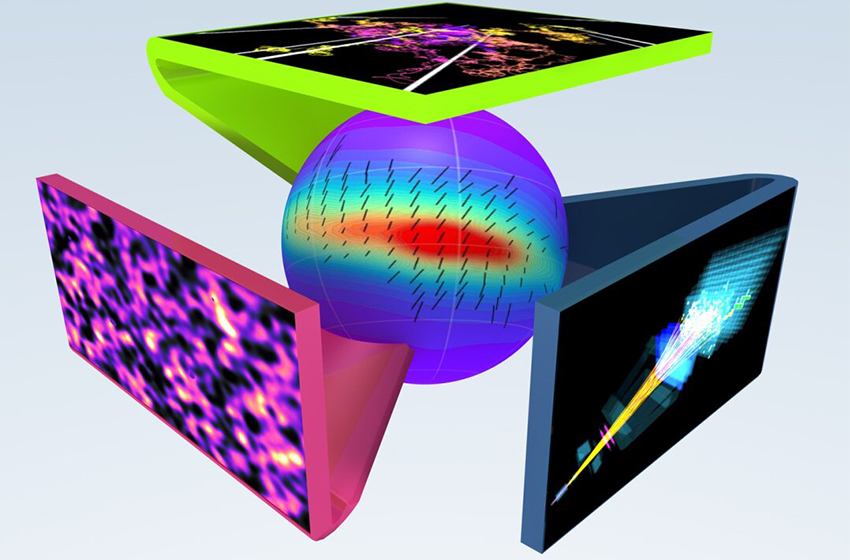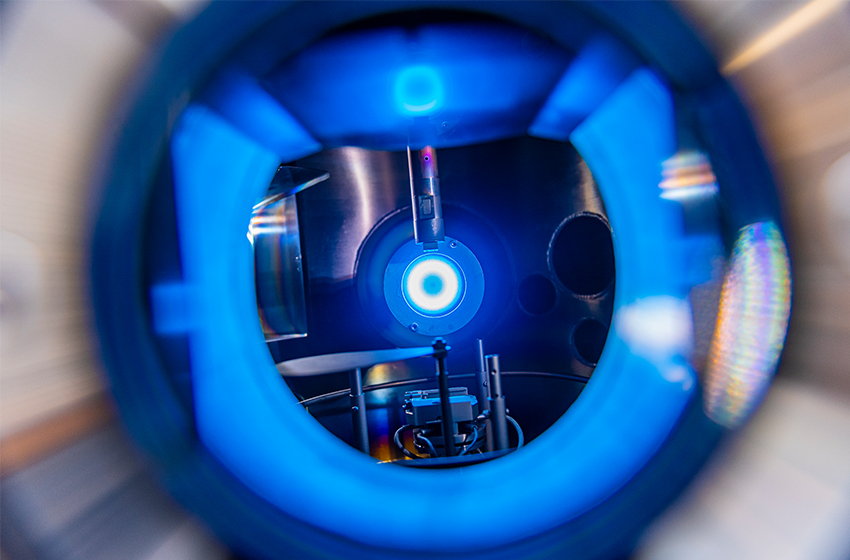Collaborative Research Centres
The faculty is involved in various collaborative research centres, two of which have a spokesperson role in Bochum.
Collaborative Research Centers are long-term research institutions in which researchers work on a joint, interdisciplinary research program for a period of up to twelve years. The aim of these institutions is to work on innovative and long-term research projects by coordinating and concentrating people and resources within the universities. In this way, institutional focal points and structures are to be formed. Cooperation with non-university research institutions is encouraged. Collaborative Research Centers consist of a large number of subprojects, the number and size of which depend on the research program of the consortium. The subprojects are led either by individual scientists or by groups of scientists.
SFB 1491 - Cosmic Interacting Matter

Image: SFB 1491
Despite all the progress made in the field of astrophysics, the interaction of cosmic radiation and matter is still far from being adequately researched. The Collaborative Research Centre "The Interplay of Cosmic Matter - from Source to Signal" therefore aims to systematically investigate the interaction of matter and energy with a special focus on the energy transfer between magnetic fields, cosmic rays, thermal plasmas and dark matter. In doing so, it wants to contribute to deciphering the fundamental properties of matter in the universe.
Spokesperson of the SFB
Prof. Dr Julia Tjus, RUB
(Co-speaker Prof. Dr. Dr. Wolfgang Rhode)
Participating researchers at the RUB
Prof. Dr. Bomans, Dominik
Prof. Dr. Dettmar, Ralf-Jürgen
Dr Eichmann, Björn
PD Dr. Fichtner, Horst
Prof. Dr. Franckowiak, Anna
Prof. Dr. Grauer, Rainer
Prof. Dr Hildebrandt, Hendrik
Prof. Dr. Hüttemeister, Susanne
Prof. Dr Innocenti, Maria Elena
Dr Wright, Angus Hooper
Participating locations:
Ruhr University Bochum
TU Dortmund
Bergische Universität Wuppertal
SFB 1316 - Transient Atmospheric Plasmas - From Plasmas to Liquids to Solids

Image: Damian Gorczany
Within the framework of SFB 1316, the Faculty of Physics and Astronomy is involved with several PIs and, with Prof. Dr. Achim von Keudell, also takes on the role of spokesperson for the Collaborative Research Centre. In these projects, the electric fields in short-pulse plasmas and the non-equilibrium excitation of molecules are investigated. Furthermore, plasma arrays and the functionalisation of catalyst surfaces with combined and plasma and laser radiation as well as by plasmas at the solid-liquid interface are being investigated.
Spokesperson of the SFB
Prof. Achim von Keudell, RUB
(Deputy spokesperson Prof. Dr. Martin Muhler, RUB)
Participating researchers at the RUB (Faculty of Physics and Astronomy)
Dr Böke, Marc
Prof. Dr. Czarnetzki, Uwe
Prof. Dr. Golda, Judith
Dr Grosse, Katharina
Dr Lepikhin, Nikita
Dr Luggenhölscher, Dirk
Dr Schulz-von der Gathen, Volker
Participating locations:
Ruhr University Bochum
University of Ulm
Fritz Haber Institute of the Max Planck Society (FHI) Berlin
Research Centre Jülich
SFB/TRR 288 - ELASTO-Q-MAT
The ELASTO-Q-MAT initiative of the SFB-TRR 288 aims to understand and utilize novel physical phenomena of solids resulting from a particularly strong coupling between the elastic properties of the material and its electronic quantum phases. To this end, the effects of elastic tuning and elastic response of different types of electronic order are investigated in representative classes of quantum materials that are characterized by high sensitivity of their properties to internal strain or external pressure. Prominent examples of such electronic order states are magnetism, charge and orbital order, nematic order, superconductivity, electronic ferroelectricity and topological quantum states. The physical phenomena to be investigated include non-linear and non-equilibrium elasticity, magnetoelastic resistance, critical elasticity, and superelasticity due to a volume collapse phase transition. The elastic reactions of the material are to be used to set symmetry-breaking phases and to switch between them. In addition, novel experimental techniques will be developed from this, such as spatially resolved measurement of the lattice vibrations. By combining material design (partly guided by theoretical considerations), material synthesis and characterization with novel experimental techniques for the mechanical manipulation of electronic systems, we intend to be able to specifically adjust both the elastic behavior and the electronic properties. In addition to well-established experimental and theoretical methods, we also use newly developed techniques, some of which are only available in this network.this initiative brings together scientists from three universities and two Max Planck Institutes. The participating scientists, who have already worked together in a variety of ways and whose expertise complements each other ideally, can already show decisive contributions to this field of research. The long-term goals of our initiative are: i) to develop a systematic understanding of physical phenomena on very different time scales resulting from a strong coupling between electronic order and the crystalline lattice. ii) to produce and understand novel quantum materials with exceptional elastic behavior and to explore the potential to generate new functionalities from the interplay between mechanical and electronic properties.
Source: https://gepris.dfg.de/gepris/projekt/422213477
Prof. Dr. Anna Böhmer is involved in TRR 288.
SFB/TRR 287 - Bulk Reaction
In the SFB/TRR 287, which has been established since 07/2020, the Wiedner and Fritsch working groups are involved in the non-invasive investigation of particle movements in complex bulk flows of particles. Such movements determine, for example, the efficiency of solid-state furnaces or drying or roasting systems.
For this purpose, the working groups are building a large-volume scanner based on positron emitter tomography, which can not only track individual particles, but also determine the spread and distribution of hot gases within the debris. The work is being carried out in close collaboration with the Chair of Energy Systems and Energy Process Technology (Prof. Viktor Scherer) at the RUB and the University of Magdeburg.
SFB TR 110 - Symmetries and the Emergence of Structure in QCD
SFB Transregio 87 - Pulsed high-performance plasmas for the synthesis of nanostructured functional layers
Within the framework of SFB TR 87, the physics faculty is involved with the four PIs Prof. von Keudell, Dr. Schulz-von der Gathen, Dr. Böke and Dr. Prenzel. In these projects, the dynamics of pulsed magnetised plasmas, elementary processes at the plasma-solid interface and the synthesis of barriers and membranes by means of PECVD processes are investigated. Furthermore, physics is in charge of the public relations project of the SFB TR.
Participations:
- Aachen
- Bochum
- Paderborn
- Cottbus
- Kiel
You can find more information on the SFB website.

